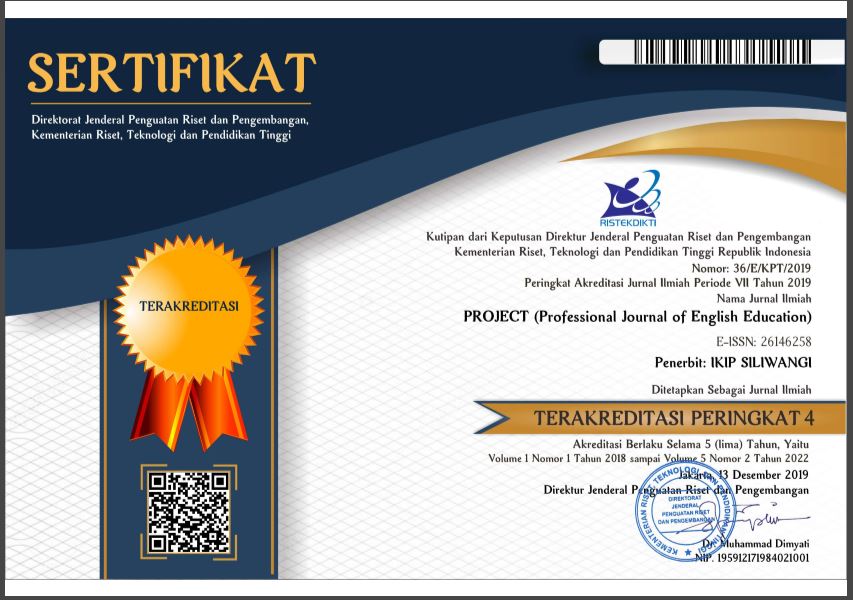LEARNING PHONEME IDENTIFICATION USING READING ALOUD TECHNIQUE: EFL LEARNERS’ PERCEPTION
Abstract
This research proposed to figure out about students’ perception in learning phoneme identification using reading aloud. The research is a descriptive qualitative research. The research involved 17 students as the respondents. The researchers utilized questionnaires and interview in collecting the data. The results of this research revealed that most of the respondents (76.47%) had positive responses toward the use of reading aloud. The data from interview also revealed several benefits that the students obtained after learning by using Reading aloud such as having new knowledge in pronunciang each phoneme properly, reading aloud offers not only joyful but also enthusiasm booster in learning, by reading aloud, students can identify their own mispronunciation, and reading aloud has an imitation method which help students in sharping students’ oral-fluency.
References
Alhumsi, M. H. (2020). The influence of phonemic awareness instruction on EFL emergent readers word recognition. Language Literacy: Journal of Linguistics, Literature, and Language Teaching, 4(1), 1-14.
Allouh, T. M. (2021). Efl Teachers'knowledge And Beliefs About Phonological Awareness And Phonics In Reading Instruction For Early Graders In Qatari Government Schools (Master's Thesis).
Ariati, J. (2020). Analysing Reading Skill in National Plus School Curriculum: Phonological Awareness of Young Learners. REiLA: Journal of Research and Innovation in Language, 2(2), 70-75.
Busetto, L., Wick, W., & Gumbinger, C. (2020). How to use and assess qualitative research methods. Neurological Research and practice, 2(1), 14.
Cardis, A., & Fastame, M. C. (2023). Phonemic awareness of schoolers test assessment (PASTA): A pseudoword blending task for Italian pupils. Psychology in the Schools, 60(8), 2744-2761.
Erickson, Z. C. (2021). The Role of Phonemic Awareness in Reading Development in the Primary Grades.
Faraby, I., & Kamaruddin, A. (2021). Perceptions of EFL learners on the application of reading aloud technique in learning pronunciation. e-Journal of ELTS (English Language Teaching Society), 9(1), 53-64.
Gibson, S. (2008). Reading aloud: a useful learning tool?. ELT journal, 62(1), 29-36.
Gillon, G. T. (2017). Phonological awareness: From research to practice. Guilford Publications.
Irnanda, S. (2018). Phonological awareness and word reading development in Acehnese-Indonesian bilinguals learning English as a third language (Doctoral dissertation).
Moleong, L. J. (2013). Qualitative research methodology revised edition. Bandung: PT Remaja Rosdakarya Offset Publisher.
Mramboa, A., & Ligembe, N. (2022). Challenges Pupils Face in Learning Phonological Skills: A Case of Bunda District, Tanzania. East African Journal of Education and Social Sciences, 3(1), 49-60.
Ocvika, R. P. D. (2017). Teaching-Learning Pronunciation Through Reading Aloud Technique At The Second Semester Of The Eighth Grade Of SMP Negeri 2 Gading Rejo 2016/2017 Academic Year (Doctoral dissertation, UIN Raden Intan Lampung).
Pratama, R. (2022). Teaching English By Using Reading Aloud Strategy: Its Effect On Students’pronunciation Ability At Mts Darul Ulum Sukaraja (Doctoral Dissertation, Universitas Islam Negeri Sultan Syarif Kasim Riau).
Prihlaksono, S. (2019). The effect of interactive read aloud (ira) on young learners’ vocabulary development and reading comprehension a quasi-experimental study for public elementary schools in South-Tangerang (Master's thesis, Jakarta: Fakultas Ilmu Tarbiyah dan Keguruan UIN Syarif Hidayatullah).
Schrum, M. L., Johnson, M., Ghuy, M., & Gombolay, M. C. (2020, March). Four years in review: Statistical practices of likert scales in human-robot interaction studies. In Companion of the 2020 ACM/IEEE International Conference on Human-Robot Interaction (pp. 43-52).
Senawati, J., Suwastini, N. K. A., Jayantini, I. G. A. S. R., Adnyani, N. L. P. S., & Artini, N. N. (2021). The benefits of reading aloud for children: A review in EFL context. IJEE (Indonesian Journal of English Education), 1(1), 80-107.
Siahaan, M. L. A., Napitupulu, S., & Marpaung, T. I. (2023). The Effect Of Reading Aloud Strategy To The Students’ Pronunciation Abiity For Grade Seven Of SMP Negeri 3 Pematangsiantar. Jurnal Ilmu Pendidikan Dan Sosial, 2(4), 428–437. https://doi.org/10.58540/jipsi.v2i4.450
Siddiqui, M. M., & Naz, T. (2019). Implementing The 3r Strategy in ELT: A Case Study with Arab Learners of English Language. International Journal of EFT, Linguistics and Comparative Literature, 7(6). https://doi.org/10.33329/elt.76.10
Sundari, D. T., Nugraha, M. A., & Sunara, S. (2023). The Analysis of Pronunciation Errors: Students’ Reading Aloud. JEPAL (Journal of English Pedagogy and Applied Linguistics), 3(2), 96-110.
Simmons, L. K. (2021). Impact of an Emergent Reading Skills Intervention on Letter Recognition and Phoneme Identification in Pre-Kindergarten Children. Louisiana State University and Agricultural & Mechanical College.
Syiyami, I. A., Haryanti, E., Nurwanti, D. I., & Kurniawati, N. (2021). The Use of Reading Aloud Method to Improve Students’ Speaking Ability: Indonesian Secondary School.
Tanujaya, B., Prahmana, R. C. I. P., & Mumu, J. (2022). Likert Scale in Social Sciences Research: Problems and Difficulties. FWU Journal of Social Sciences, 16(4), 89–101. https://doi.org/10.51709/19951272/Winter2022/7
Vetsch-Larson, M. (2022). Effects of Phonemic Awareness and Oral Reading Fluency Effects of Phonemic Awareness and Oral Reading Fluency Effects of Phonemic Awareness and Oral Reading Fluency A Project Presented to The Graduate Faculty of Minnesota State University Moorhead. https://red.mnstate.edu/thesis/616
Wardana, I. K., Astuti, P. T., & Sukanadi, N. L. (2022). Examining the effect of phonological awareness instruction on EFL learners’ pronunciation and motivation. Erudita: Journal of English Language Teaching, 2(2), 129-147.
Widnyana, I. W. A., Permana, I. G. Y., & Pratama, P. G. A. (2023). Teacher’s Experiences of Online Assessment Implementation in Teaching English. PROJECT (Professional Journal of English Education), 6(5), 979-990.
Downloads
Published
Issue
Section
License

This work is licensed under a Creative Commons Attribution-ShareAlike 4.0 International License.




